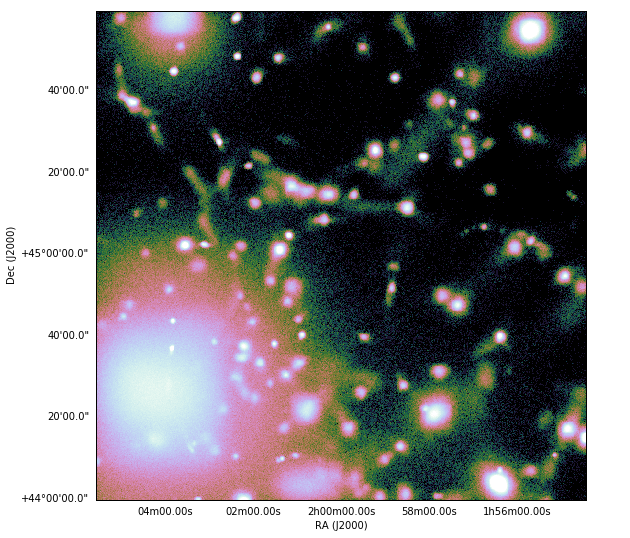Generating Light Cone Simulations of X-rays¶
Light cones are created by stacking multiple datasets together to continuously span a given redshift interval. To make a projection of a field through a light cone, the width of individual slices is adjusted such that each slice has the same angular size. Each slice is randomly shifted and projected along a random axis to ensure that the same structures are not sampled multiple times. For more information about how light cones are created and used in yt, see this documentation.
Note
This functionality requires installing the yt_astro_analysis package, To do this, checkout the installation documentation.
The XrayLightCone object allows
one to make a projected set of X-ray events from a light cone solution,
combining yt’s light cone machinery with the X-ray photon generation
capabilities of pyXSIM. The dataset used in this example is the
Enzo_64 dataset and can be
downloaded from http://yt-project.org/data.
Warning
This feature is currently in beta, and only works for Enzo or Gadget-based cosmological simulations. In the future, it will be expanded to other types of datasets. If you’d like to see support for your type of dataset, get in contact!
First, one needs to create the
XrayLightCone object:
parameter_filename = 'Enzo_64/64.param' # parameters for the simulation
simulation_type = "Enzo" # For now, this and Gadget are only options that work
near_redshift = 0.0
far_redshift = 0.9
lc = pyxsim.XrayLightCone(parameter_filename, simulation_type,
near_redshift, far_redshift)
This takes a time series of datasets from the cosmological simulation and
creates the light cone solution. There are additional optional keyword
arguments (which are the same as those taken by
LightCone).
They are:
seed(integer): If an integer is supplied here, a constant set of random numbers will be used to construct the light cone. Default: None, which will use the current system time to seed the random number generator.use_minimum_datasets(boolean): If True, the minimum number of datasets is used to connect the initial and final redshift. If False, the light cone solution will contain as many entries as possible within the redshift interval. Default: True.deltaz_min(float): Specifies the minimum \(\Delta{z}\) between consecutive datasets. Default: 0.0.minimum_coherent_box_fraction(float): Used withuse_minimum_datasetsset to False, this parameter specifies the fraction of the total box size to be traversed before rerandomizing the projection axis and center. This was invented to allow light cones with thin slices to sample coherent large scale structure, but in practice does not work so well. Try setting this parameter to 1 and see what happens. Default: 0.0.
After the XrayLightCone has been
created, we have to implement a source model to determine how the photons will
be generated from the source properties (as usual). In this case, we’ll simply
use the ThermalSourceModel:
source_model = pyxsim.ThermalSourceModel("apec", 0.1, 10.0, 1000)
Now, we are ready to generate our simulated events using
generate_events().
Since by definition a light cone is a projection, the
XrayLightCone creates both
photon and event lists together from a single call. We must specify an exposure
time, collecting area, field of view in units of angle, the source model, and
the center of the field of view in (RA, Dec). The
generate_events()
method also takes a number of the same optional parameters as
project_photons, so we’ll also absorb the events
with the wabs model and smooth the positions just a bit for visualization
purposes.
exp_time = 50000.0 # exposure time in seconds
area = 25000.0 # collecting area in cm**2
fov = (2.0, "deg") # field of view
sky_center = (30.0, 45.0) # sky center in degrees
photon_prefix = "enzo_64_photons"
event_prefix = "enzo_64_events"
lc.generate_events(photon_prefix, event_prefix, area, exp_time,
fov, source_model, sky_center, absorb_model="wabs",
nH=0.02, sigma_pos=0.5)
If we make an image of this EventList, it looks
like this:
events = pyxsim.EventList("enzo_64_events")
events.write_fits_image("light_cone_img.fits", fov, 1024)
